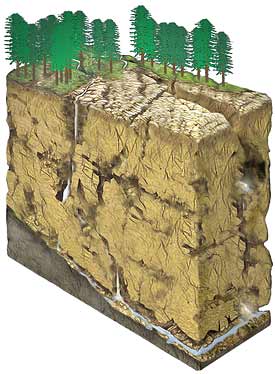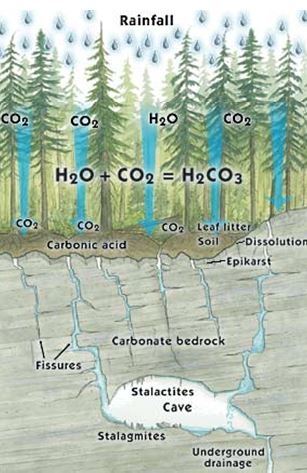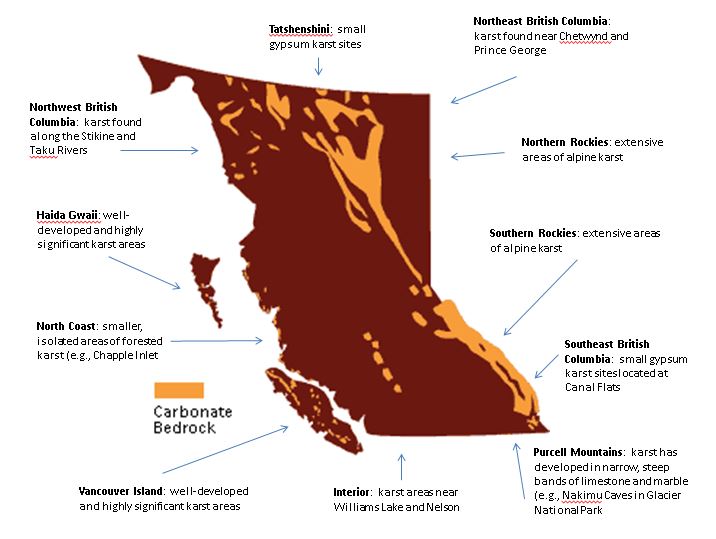Understanding karst (lesson 1, part 1)
On this page
Learning objectives
This lesson covers basic background information on karst systems, processes and values, especially in relationship to the British Columbia forest environment. By working through this lesson you will be able to:
- Understand the carbon dioxide cascade
- Identify the distribution of potential karst in British Columbia
- Understand the important values of karst
Introduction
This lesson introduces you to basic information about karst terrain, where it exists in British Columbia, and why karst is important. Throughout this course you will find links to the Karst Management Handbook for British Columbia at the bottom of the side navigation on the left. If you want more specific information on any of the areas you are studying, just click on this link. You are encouraged to evaluate your learning by completing the self-check exercises. They don’t take long and will help you review the concepts that you have worked through.
What is karst?
Karst – a distinctive topography that develops as a result of the dissolving action of water on soluble bedrock (usually limestone, dolomite, marble, and, to a lesser extent, gypsum), which produces a landscape characterized by fluted and pitted rock surfaces, vertical shafts, sinkholes, sinking streams, springs, subsurface drainage systems and caves.

The unique features and three-dimensional nature of karst landscapes are the result of complex interplays between geology, climate, topography, hydrology and biological factors that happen over many thousands of years.
How is karst formed?
Karst is formed in carbonate bedrock through what is called the carbon dioxide (CO2) cascade. The main steps of the CO2 cascade are:
- Rain picks up CO2 as it falls
- The rain trickles into the soil where it picks up more CO2 and becomes a weak solution of carbonic acid
- The carbonic acid solution percolates through the ground into joints and fractures in the bedrock
- The bedrock gradually dissolves, creating underground streams, caves, etc

As rain falls through the atmosphere, it picks up CO2, which dissolves in the droplets.
When the rain hits the ground, it percolates through the soil and picks up more CO2 to form a weak solution of carbonic acid: H2O + CO2 = H2OCO3,
The infiltrating water naturally runs into any existing joints or fractures in the bedrock. With a continuous supply of CO2-enriched water, the carbonate rock eventually begins to dissolve, creating larger openings for the water to follow.
Where is karst found?
Carbonite bedrock underlies approximately 10% of British Columbia, providing an extensive area for potential karst development.
Is all carbonate rock in B.C. potential karst?
No, the level of karst development across the province is highly variable, because it depends on the type and purity of bedrock, physiographic location and biogeoclimatic settings. Glaciation has played a major role in the karst formation process in B.C. by exposing, eroding and burying earlier developed karst. The extensive glacial deposits commonly associated with the Interior likely mask significant areas of buried karst terrain.
B.C. karst on a global scale
Much of the karst in B.C. is comparable to karst terrain in other parts of the world (for example, Europe, Norway, Alaska, Tasmania, Chile, New Zealand). Timber harvesting concerns in B.C. have focused primarily on the karst on Vancouver Island, the Queen Charlotte Islands, and the mainland coast where the karst contributes to a rich growing environment for timber. These areas have very steep surface slopes and subsurface hydraulic gradients with very high levels of rainfall. These characteristics contribute to making these among the most dynamic karst terrains on earth, as they are evolving and changing more rapidly and abruptly than karst areas in more moderate settings.
Self check - questions
Answer either True or False to check your understanding.
- Karst is formed through the interaction between water, carbon dioxide and carbonate bedrock
- Limestone and dolomite are examples of soluble bedrock
- Carbonate bedrock underlies approximately 20% of British Columbia
Self check - answers
- True
- True
- False


